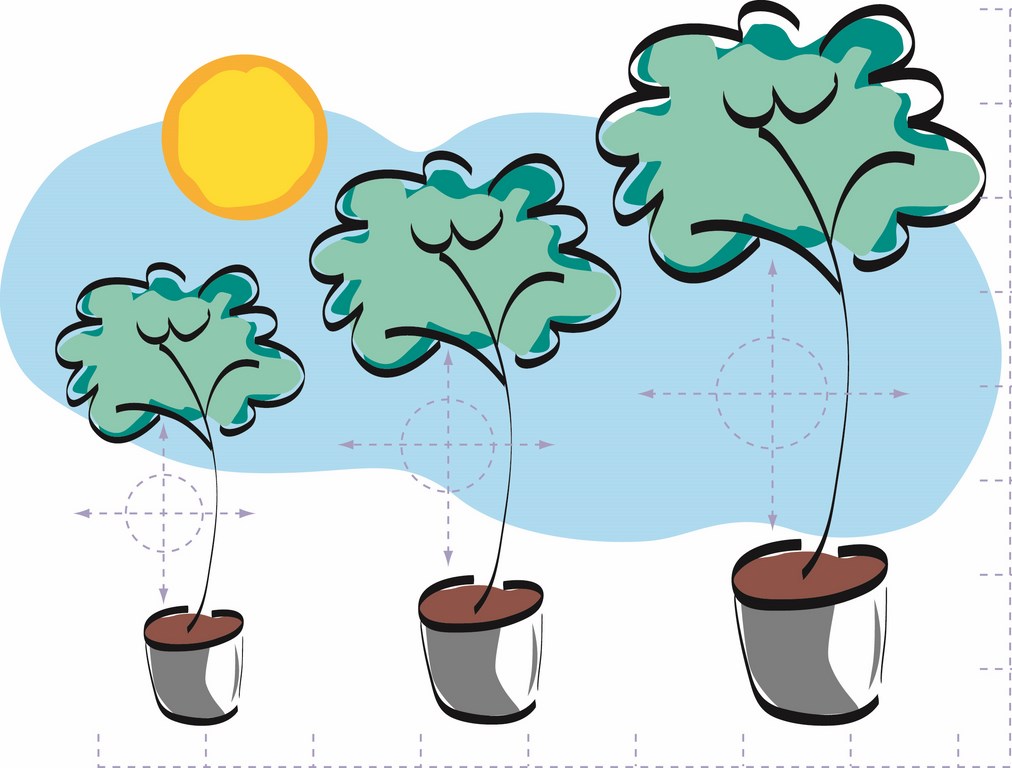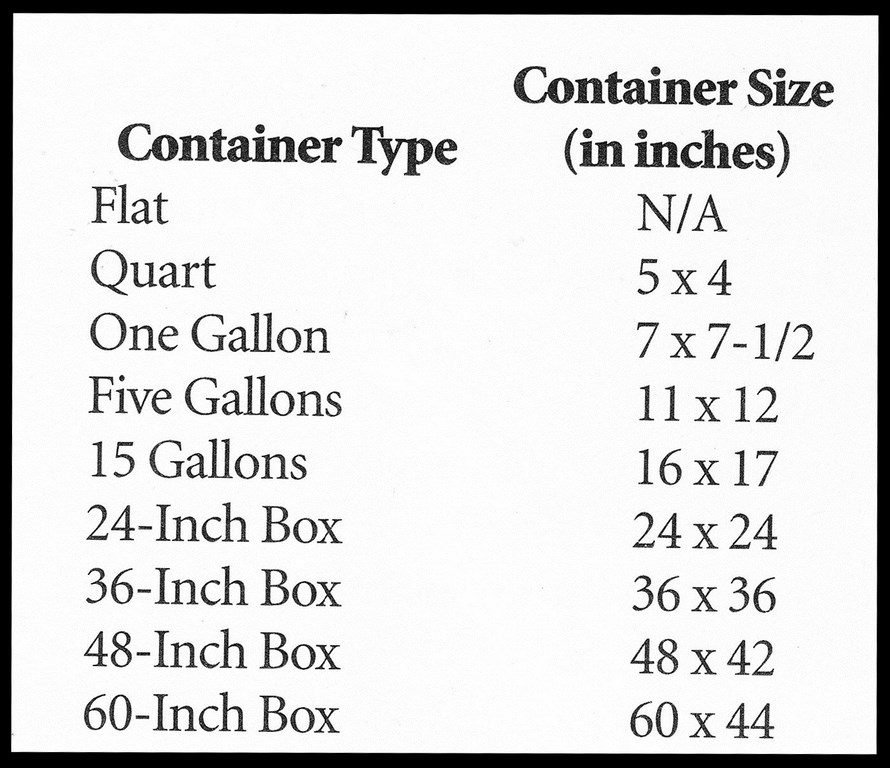Size Does Matter

Surely you’ve heard this line before and never believed it, but I’m here to tell you that size does matter.
Have you ever, for example, built a pond or fountain with concrete either surrounding it or fanning out from it beneath the soil – and then had your clients say they wanted a very mature tree or shrub planted right up against the edge? There you are with six inches of soil (maximum!) to work with, and there’s just no way to get a 24-inch box into the space.
Now what?
The size of the plant itself, the size of its container and the size of the hole into which it’ll be placed all need to be taken into consideration from the start if you want your final product to be its best. By considering the sizes of the plants your clients want, you can better accommodate them in your overall design, eliminate problems before they arise and make yourself a hero in your clients’ eyes.
THINKING ABOUT SIZE
Say, for instance, that your clients want a tropical look with palms, ferns and other large-leaf plants. Assume also that they don’t want to wait years for the palms in particular to mature to a reasonable size – and are willing to pay for a large container.
Generally, palms are very slow growers. To get one that fits these clients’ needs, you’ll probably have to use a 24-inch box, or perhaps even a larger container. A 2-foot-high Phoenix roebellini (pygmy date palm), for example, will usually only be found in 24-inch (or larger) boxes. This requires a planting space at least 2 feet in depth.
If your plan provides for this space, there’s no problem. If not, your clients may ask you to tear out part of the watershape to accommodate the plant – which could be disastrous. The clients will be unhappy because the design won’t look the way they envisioned it, and you’ll be upset because you have to jeopardize the integrity of your structure or plumbing to allow for something that should have been considered from the start!
That’s why I make it a policy to ask, before we break ground, what types of plants my clients want in their yards and, in a general sense, where they want them. Now is the time to determine how close to the watershape the plants will be and where the planting beds will go.
But don’t stop there! As I said before, if your clients know what plants they want and can clearly draw or explain it to you, you’re ahead of the game. If not, it’s time to bring in a landscape architect or designer.
WORKING WITH A PLAN
Drawings and plans are always the best way to avoid mistakes – and having them in hand before you begin your watershaping project is the best tool you can have as you do your own designing and planning. You won’t have to make “field adjustments,” for example, or stop in midstream to re-coordinate with the other trades involved in the project. Distractions of these kinds can cost you lots of time and money.
Incidentally, if your clients aren’t comfortable working with a plan and would rather plant “visually” later in the project, my suggestion is to avoid problems by assuming they’ll want the largest, most mature plants possible right up against the edge of your watershape. If that’s not what they decide, you’ve given yourself plenty of flexibility.
When it comes to plantings, there are two main considerations: the types of plants and the sizes of their containers. Let’s look at plant types first, then turn our attention to the chart that follows.
[ ] Ground cover: These plants usually come in flats or quarts but sometimes even in 1-gallon containers. They usually require the least amount of planting space; under any circumstances, however, your safest bet is to leave at least six inches of soil depth.
[ ] Shrubs, perennials and annuals: This category constitutes the largest group of plants. They may come in every sort of container from flats to 24-inch boxes; generally, however, herbaceous perennials and annuals come in quarts and one- or five-gallon containers. The smaller plants will require the minimum six-inch soil depth.
[ ] Trees: The smallest containers in which most trees are sold are 15 gallons. If your clients tell you they want a tree, it’s safe to assume you’ll need space for a container of at least that size in your plan. But I suggest it’s better to be safe than sorry: Leave room for at least a 24-inch box.
It’s also important beforehand to determine whether or not the selected plants have invasive root systems. It would be a shame, after all, if the roots of the ficus you planted up against your clients’ pond ended up cracking the shell in two! Bottom line: If you know what types of plants you’ll be installing and where, you can allow for enough planting space, please your clients and avoid headaches later on.
So what size planting spaces do different plants need? Basically, it’s all determined by the size of the containers they come in, and here’s a handy chart to help you in your planning:
 (In each case, the first number refers to the diameter or width of the container, and the second refers to its depth. The dimensions indicate at a minimum the size of the hole you need to dig.)
(In each case, the first number refers to the diameter or width of the container, and the second refers to its depth. The dimensions indicate at a minimum the size of the hole you need to dig.)
Some plants come with the root ball wrapped in burlap. In these cases, check with the nursery, because the required planting space will vary with the size and height of the plant.
IN THE TRENCHES
As you think about planting space, it’s also important to remember that the plants will have to cohabitate with all of your plumbing. How deep are your lines and how does their space align with plantings? You don’t need me to tell you what the codes say about burying your lines; I will suggest that you need to think things through if they are to be buried beneath planting beds.
Lines buried 18 inches below grade may meet the plumbing codes but won’t give you room to plant anything larger than a five-gallon plant above them. Knowing where the planting beds will be ahead of time can help you direct your plumbing under lawns or other expanses that only need shallow planting spaces.
Now is the time, by the way, to consult with the landscape contractor to see if your lines and theirs can go in the same trenches. Bringing in these contractors while other plumbing is being installed will make your job easier and, more important, will let them see exactly what’s in the ground and where. Pick axes and shovels have an interesting way of divining where pool plumbing lines are buried. Coordination of trades here is crucial.
Another problem we’ve encountered is when plumbing and electrical lines are set right up against a house or other structure. Having a plan (or at the very least a discussion with the clients) will tell you whether a vine or some other large plant will need to be planted to cover an unsightly wall, for example. Frequently, plants used to cover these large areas come in (minimum) 15-gallon containers.
This is often an issue right around equipment pads. Most clients simply don’t know that the enclosure may have a 3-by-3 footing and that you won’t be able to plant anything bigger than a 1-gallon plant against it.
Of course, you have the option of moving the pad to a less conspicuous space or working with the clients to redesign the area so you can plant 15-gallon shrubs in front of the concrete-block wall. If you have no choice other than the original spot and your clients still want you to hide the wall, you might want to consider a lattice or a bamboo enclosure – whichever will work better in the overall design.
The key here is to get creative and show your clients that you can work with them to resolve the problem. Indeed, creativity can be your best ally in keeping your clients happy and setting yourself up for future referrals.
So as you can see, size does matter. And knowing that simple fact can make everything fit better.
Stephanie Rose wrote her Natural Companions column for WaterShapes for eight years and also served as editor of LandShapes magazine. She may be reached at sroseld@gmail.com.










